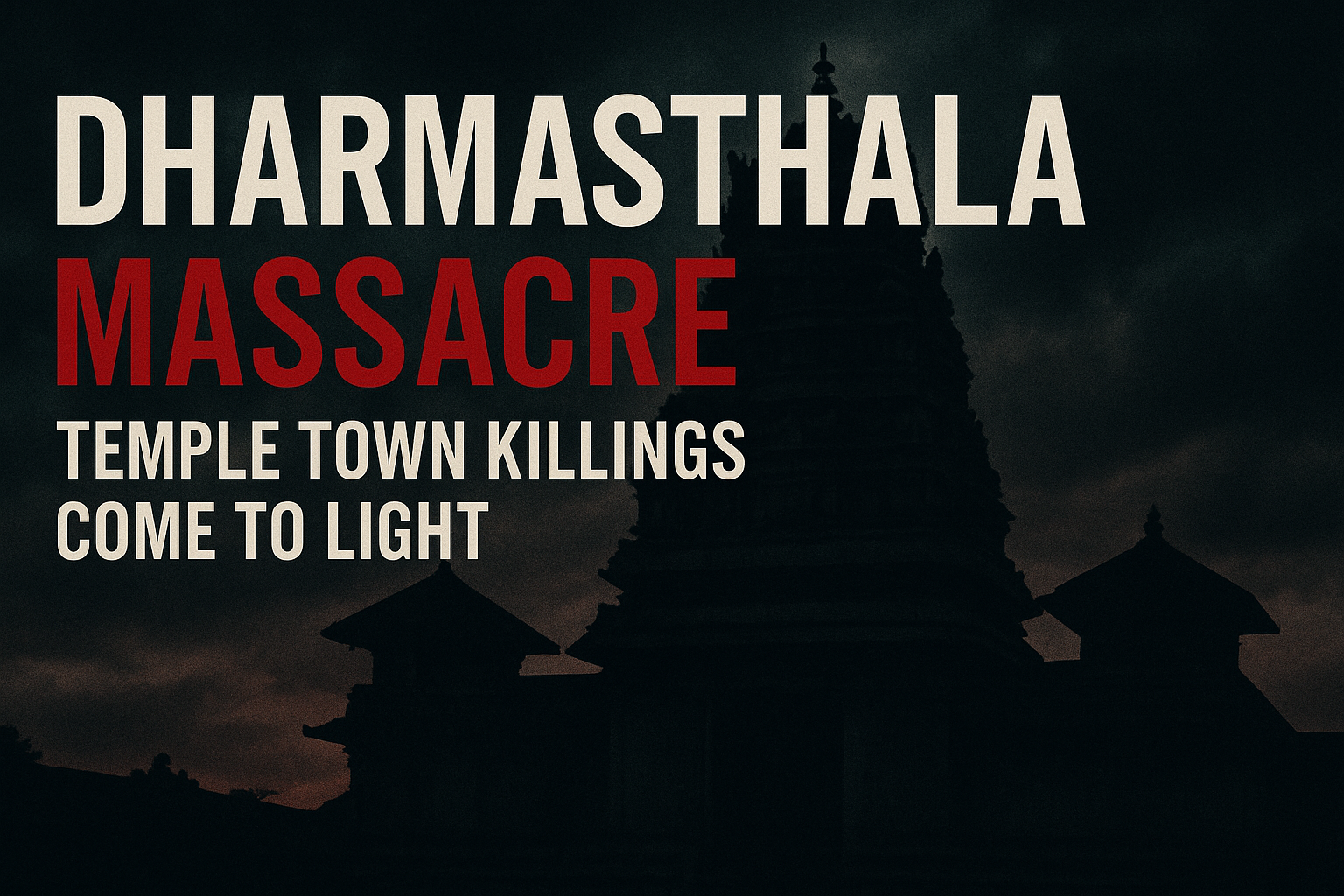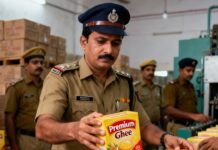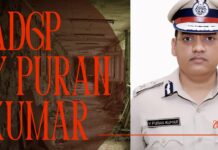Dharmasthala Massacre: Temple Town Killings Come to Light
Statue of Lord Bahubali at Dharmasthala Temple. Dharmasthala, an 800-year-old pilgrimage town in Karnataka, is at the centre of an unprecedented crime scandal. In July 2025 a former sanitation worker at the revered Dharmasthala Temple came forward claiming he had been forced for nearly two decades to bury hundreds of bodies – many women and girls – in secret graves along the Netravathi River. He described victims with signs of rape, strangulation and acid burns, alleging that powerful temple supervisors had threatened him with death and even the killing of his family if he did not comply. These explosive allegations – widely reported in Karnataka crime news – instantly transformed a tranquil temple town into the scene of a macabre mass grave investigation.
The whistleblower’s revelations emerged after years of local suspicions. Dharmasthala had seen sporadic protests since the 1980s over unexplained deaths and missing women, including the notorious “Justice for Sowjanya” campaign in 2012 after a teen’s rape-murder. On July 3, 2025, under heavy protection, the complainant formally lodged his complaint. Police confirmed that he “reported that he had personally buried hundreds of bodies” between 1995 and 2014 under duress. He even submitted a human skull he had exhumed to authorities. The claims included detailed accounts – for example, finding a 13-year-old schoolgirl’s body with her uniform but missing skirt and undergarments, her neck showing strangulation marks. His full statement, recorded on July 11, painted a chilling picture of systematic temple abuse cases, part of what he described as a decades-long pattern of crimes that had been covered up.
Timeline of Key Events
- 1987: Protests erupt in Dharmasthala after the rape and murder of 17-year-old Padmalata, raising suspicions of powerful cover-ups.
- 2003: Medical student Ananya Bhat vanishes on a college trip to Dharmasthala. Her mother Sujatha Bhat later alleges police stonewalled the case.
- 2012: The #JusticeForSowjanya movement fights for answers after 17-year-old Sowjanya is found murdered; locals suspect temple connections.
- June 22, 2025: The whistleblower’s lawyers announce his readiness to provide evidence, including an exhumed body he claimed to have unearthed.
- July 3: The 48-year-old Dalit complainant files a police complaint at Dharmasthala PS, demanding protection; the case is registered under new penal code provisions.
- July 4: Official case registration; Karnataka police begin investigation and grant the man official witness protection.
- July 11: The protected witness appears in Belthangady court (shrouded in black) to record his statement under Section 164 CrPC. He submits skeletal photos and a human skull as evidence.
- July 17: Lawyers for the complainant write to the Chief Justice of India alleging leaked police notes of his testimony. Demand for a high-level probe grows nationwide.
- July 19: The Karnataka government constituting a Special Investigation Team (SIT), led by DGP Pronab Mohanty, to probe the mass-grave allegations. Senior officers M.N. Anuchet, Soumyalatha and J.K. Dayama are named to the team.
- July 25-27: The SIT takes over case files from local police. On July 27, the whistleblower (complainant) formally points out 13 suspected burial sites in Dharmasthala’s forests, as described in his complaint.
- July 28–30: Excavations begin at the sites with full forensic and police presence. The first five marked sites (along the riverbank) yield no human remains.
- July 31: At Site 6, forensic teams recover partial human skeletal remains buried about four feet deep. These include broken skull fragments believed male. The bones are secured for DNA analysis.
- Aug 1-2: Digging continues. Site 7 (forest) yields about 15 more bones (tentatively male). Sites 7 and 8 initially show no remains; work shifts to Site 9.
- Aug 2025 – present: Excavations and forensic tests continue. The SIT has set up an office and helpline in Mangaluru, urging tip-offs from the public. All related missing-person and unnatural-death cases in Karnataka are being transferred to the SIT.
Key Witnesses and Suspects
- The Whistleblower (Complaining Witness): A 48-year-old Dalit man, ex-sanitation worker at Dharmasthala (1995–2014). His identity is court-protected. He alleges he “buried dead bodies in several locations” at the temple’s behest, and vividly describes crimes he witnessed (rape-murders of women and children, plus killings of destitute men). He claims to have lived in hiding since 2014 and only broke silence under overwhelming guilt. He insists on guiding police personally to unmarked graves, fearing tampering of evidence.
- Legal Representatives: The man’s lawyers (including senior lawyer S. Balan and advocates Ojaswi Gowda, Sachin Deshpande, etc.) have actively pressed for a thorough probe. They petitioned courts and the media to ensure his protection and the formation of the SIT.
- Families of Victims: Some have come forward after the story broke. Notably, Sujatha Bhat, mother of missing 2003 medical student Ananya Bhat, filed a fresh police complaint recently, convinced her daughter could be among the victims. She said old investigators had once forced her case to be dropped under intimidation. Other local families of disappeared women (from Padmalata, Vedavalli, Yamuna cases, etc.) are demanding these cold cases be reopened under the SIT’s ambit.
- Temple Authorities: Dharmasthala temple is led by the influential Heggade family (21st Dharmadhikari Veerendra Heggade is a Rajya Sabha MP). Although the allegations stem from within the temple premises, no temple official has been publicly named in the FIR. The temple trust has issued statements welcoming the investigation. Spokesperson K. Parshwanath Jain said they “sincerely hope the SIT conducts a thorough and impartial investigation and brings out the true facts to light.”
- Suspects: The whistleblower alleges that the crimes were orchestrated by “powerful individuals” at or connected to the temple. He claims his supervisors threatened him with the words “We will cut you into pieces; your body will also be buried like the other corpses; we will sacrifice all your family members” if he disobeyed. These unnamed figures (not identified by name in media reports) are believed to include high-ranking temple employees or patrons. The police have so far neither named nor charged any individuals in connection with the burials; investigation is ongoing to determine responsibility.
Authorities Step In: Dharmasthala SIT Investigation
Under mounting public and political pressure, the Siddaramaiah-led Karnataka government mobilized its resources. On July 19, it officially constituted a Special Investigation Team (SIT) under DGP Pronab Mohanty. Alongside Mohanty, the SIT includes DIG M.N. Anuchet, officers Soumyalatha and J.K. Dayama among others. The SIT was tasked with re-examining decades of unsolved crimes in the region and probing the whistleblower’s burial-site claims. All relevant case files were handed over to the SIT by July 25.
Using satellite maps, local surveys and the witness’s guidance, the SIT team marked 13 suspected grave sites around Dharmasthala’s old town, many near the Netravathi bathing ghat. The exhumations began on July 28 under tight security, with revenue and forest officials, forensic experts and a dog squad present. For the first five sites, investigators found no human remains. The team also seized several personal items: for example, at Site 1 they recovered a torn blouse and a PAN card belonging to a woman named Lakshmi, currently being analysed. Additionally, SIT officers collected Unnatural Death Records (UDRs) from the Dharmasthala gram panchayat dating 1995–2014 as mentioned by the whistleblower.
At Site 6 (excavated July 31), the SIT made a breakthrough: partial human skeletons and skull fragments were unearthed. The area was immediately cordoned off and covered with tarpaulins to prevent contamination. Authorities documented the bones meticulously on-site and packaged them for DNA and forensic analysis at the State FSL. The SIT then moved on to Sites 7 and 8; as of early August, Site 7 also yielded partial remains (preliminarily a male), while Site 8 had none. The SIT is reportedly considering ground-penetrating radar scans to locate any additional graves, though Kerala’s heavy monsoon rains have hampered some digging.
Throughout the probe, SIT leader DGP Mohanty has emphasized caution. The recovered bones are being analyzed in batches (to ensure coordinated forensic study). In parallel, the SIT has issued a public helpline (0824-2005301, email sitdps@ksp.gov.in) and set up a drop-in centre in Mangaluru, encouraging locals to provide tips or report missing-person leads. All cases related to Dharmasthala (including the earlier Padmalata, Vedavalli, Yamuna murders and missing person cases of the past two decades) have been ordered transferred to this SIT, reflecting the investigators’ determination to fully address what many see as a long-buried conspiracy.
Political and Social Fallout
The Dharmasthala revelations have ignited widespread outrage across Karnataka. Civil society and women’s groups, long unsettled by the temple town’s dirty secrets, are demanding accountability. The Dakshina Kannada district unit of the All India Democratic Women’s Association (AIDWA) unanimously passed a resolution calling for a “fair SIT probe” and urging that all suspicious women’s deaths in Dharmasthala (Padmalata, Sowjanya, Yamuna, etc.) be investigated together. The Karnataka State Women’s Commission wrote to Chief Minister Siddaramaiah, pressing for a thorough examination of the alleged rapes and murders and better security for the complainant.
Politically, there have been heated exchanges. The Opposition BJP and local leaders have cited the scandal to criticize the Congress government’s handling of temple affairs, even as Siddaramaiah publicly said (on July 18) he would not oppose an SIT probe if police so recommended. On July 17, Siddaramaiah remarked that the whistleblower “has now given a statement…He says he buried bodies and is ready to show the locations. Let us see what the police say,” indicating cautious support for the investigation. Temple authorities – led by Padma Vibhushan awardee Veerendra Heggade – have maintained a cooperative stance. On July 20 the temple’s spokesperson issued a statement acknowledging the public’s demand for truth and urging the SIT to “conduct a thorough and impartial investigation” into the allegations.
In the broader public, the case is being treated as one of India’s most shocking mass grave and women’s crime stories. Media coverage has highlighted how the suspected “mass murders” in Dharmasthala relate to systemic abuse of marginalized people (the complainant is Dalit) and long-ignored missing-women cases. Activists note parallels to other temple scandals and demand that caste and power dynamics not hinder justice. At the local level, families who once felt silenced are now emboldened. Outside the courthouse in Belthangady, crowds of villagers have demonstrated with placards demanding DNA testing and divine justice for the victims.
Amid the furor, several legal petitions have been filed. The complainant’s lawyers have approached higher courts seeking formal witness protection and a court-monitored investigation after alleging police leaks. Rights groups are seeking supervision by the National Human Rights Commission or even the Supreme Court, given the case’s gravity. The SIT itself has also received direct direction from the government to report daily to the DGP & IGP, underscoring the immense political weight behind this inquiry.

















